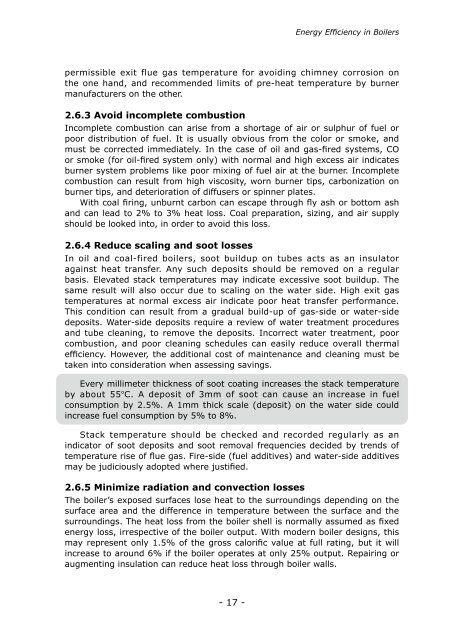Training Manual on Energy Efficiency - APO Asian Productivity ...
Training Manual on Energy Efficiency - APO Asian Productivity ...
Training Manual on Energy Efficiency - APO Asian Productivity ...
Create successful ePaper yourself
Turn your PDF publications into a flip-book with our unique Google optimized e-Paper software.
- 17 -<br />
<strong>Energy</strong> <strong>Efficiency</strong> in Boilers<br />
permissible exit flue gas temperature for avoiding chimney corrosi<strong>on</strong> <strong>on</strong><br />
the <strong>on</strong>e hand, and recommended limits of pre-heat temperature by burner<br />
manufacturers <strong>on</strong> the other.<br />
2.6.3 Avoid incomplete combusti<strong>on</strong><br />
Incomplete combusti<strong>on</strong> can arise from a shortage of air or sulphur of fuel or<br />
poor distributi<strong>on</strong> of fuel. It is usually obvious from the color or smoke, and<br />
must be corrected immediately. In the case of oil and gas-fired systems, CO<br />
or smoke (for oil-fired system <strong>on</strong>ly) with normal and high excess air indicates<br />
burner system problems like poor mixing of fuel air at the burner. Incomplete<br />
combusti<strong>on</strong> can result from high viscosity, worn burner tips, carb<strong>on</strong>izati<strong>on</strong> <strong>on</strong><br />
burner tips, and deteriorati<strong>on</strong> of diffusers or spinner plates.<br />
With coal firing, unburnt carb<strong>on</strong> can escape through fly ash or bottom ash<br />
and can lead to 2% to 3% heat loss. Coal preparati<strong>on</strong>, sizing, and air supply<br />
should be looked into, in order to avoid this loss.<br />
2.6.4 Reduce scaling and soot losses<br />
In oil and coal-fired boilers, soot buildup <strong>on</strong> tubes acts as an insulator<br />
against heat transfer. Any such deposits should be removed <strong>on</strong> a regular<br />
basis. Elevated stack temperatures may indicate excessive soot buildup. The<br />
same result will also occur due to scaling <strong>on</strong> the water side. High exit gas<br />
temperatures at normal excess air indicate poor heat transfer performance.<br />
This c<strong>on</strong>diti<strong>on</strong> can result from a gradual build-up of gas-side or water-side<br />
deposits. Water-side deposits require a review of water treatment procedures<br />
and tube cleaning, to remove the deposits. Incorrect water treatment, poor<br />
combusti<strong>on</strong>, and poor cleaning schedules can easily reduce overall thermal<br />
efficiency. However, the additi<strong>on</strong>al cost of maintenance and cleaning must be<br />
taken into c<strong>on</strong>siderati<strong>on</strong> when assessing savings.<br />
Every millimeter thickness of soot coating increases the stack temperature<br />
by about 55 º C. A deposit of 3mm of soot can cause an increase in fuel<br />
c<strong>on</strong>sumpti<strong>on</strong> by 2.5%. A 1mm thick scale (deposit) <strong>on</strong> the water side could<br />
increase fuel c<strong>on</strong>sumpti<strong>on</strong> by 5% to 8%.<br />
Stack temperature should be checked and recorded regularly as an<br />
indicator of soot deposits and soot removal frequencies decided by trends of<br />
temperature rise of flue gas. Fire-side (fuel additives) and water-side additives<br />
may be judiciously adopted where justified.<br />
2.6.5 Minimize radiati<strong>on</strong> and c<strong>on</strong>vecti<strong>on</strong> losses<br />
The boiler’s exposed surfaces lose heat to the surroundings depending <strong>on</strong> the<br />
surface area and the difference in temperature between the surface and the<br />
surroundings. The heat loss from the boiler shell is normally assumed as fixed<br />
energy loss, irrespective of the boiler output. With modern boiler designs, this<br />
may represent <strong>on</strong>ly 1.5% of the gross calorific value at full rating, but it will<br />
increase to around 6% if the boiler operates at <strong>on</strong>ly 25% output. Repairing or<br />
augmenting insulati<strong>on</strong> can reduce heat loss through boiler walls.
















